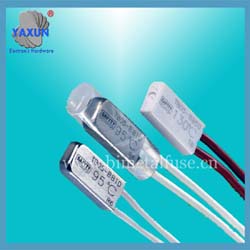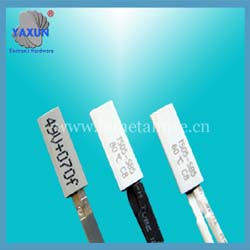Performance test of bimetal temperature switch

Set Limit, Auto Reset bimetal temperature switch, thermostat model: KSD301, KSD9700, 17AM, TB02-BB8D, SEKI ST-22, HCET, thermok SO1, klixon 6AP, Manual Reset, Adjustable Limit, 120/240V
Test conditions of bimetal temperature switch
◆ Ambient temperature 20± 5℃;◆ The relative humidity of the environment is 60%~70%;
◆ The power supply should be a sine wave power supply with rated voltage and rated frequency of 50Hz and 60Hz.
If there is no objection to the test results, the test can also be performed under the following conditions:
◆ Ambient temperature 5~35℃;
◆ The relative humidity of the environment is 45%~85%;
◆ The power supply is an alternating current close to a sine wave;

1. Working life
Connect the bimetal thermostat sample to the rated voltage, the maximum working current (deviation ±5%), and conduct the contact opening and closing test for the thermostat to increase and decrease the temperature, the maximum frequency is 6 times/min, and the closing time is 1 second. above. Close once a day as a cycle, record the number of cycles, no short circuit between poles caused by arc, and short circuit to live parts, and then check the performance. The samples shall meet the following performance indicators after being subjected to a durability test with a cycle of 100,000 times:◆ The change of the operating temperature to the initial value of the test is ±5°C below 100°C, and ±5% above 100°C;
◆ Insulation resistance above 100 MΩ (measured with DC500V insulation resistance meter and rated voltage DC500V);
◆
Can withstand the metal between the charging member and the conductive metal member close 1500V 50Hz AC voltage sine wave lasted one minute pressure test, No breakdown flashover;
◆ There is no permanent damage in function, and there is no abnormality in the reset operation of manual reset.
2. Resistance to low temperature, high temperature and thermal shock
Place the bimetallic thermostat sample in a thermostat at -20°C, keep it for 1 hour after the temperature is stable, and then take it out and place it for 2 hours. Then place the sample in a thermostat at 150°C, keep it for 1h after the temperature stabilizes, and then take it out and place it for 2h;Finally, place the sample in a thermostat at -20±3°C for 0.5h, and place the sample in a room temperature environment for 2 to 3 minutes. Then take it out in a thermostat at 150 ± 3 ℃ for 0.5 h, take it out and place it in a room temperature environment for 2 to 3 minutes as a cycle.
Continue the above 5 cycles. During the entire test, no suspected dew or water droplets should appear on the surface of the tested sample. After completion, the sample should meet the following performance indicators:
◆ The change of the operating temperature to the initial value of the test is ±3°C below 100°C, and ±3% above 100°C;
◆ Insulation resistance above 100MΩ (use DC500V insulation resistance meter and add rated voltage DC500V to test);
◆ A one-minute withstand voltage test with 1500V 50Hz AC voltage close to sine wave between charged metal parts and non-charged metal parts, no breakdown and no flashover;

3. Moisture resistance test
Put the temperature controller sample into a constant temperature box with a temperature of 40±2℃ and relative humidity for 48 hours according to the provisions of GB2423.3. The sample should meet the following performance indicators:◆ The change of the operating temperature to the initial value of the test is ±3°C below 100°C, and ±3% above 100°C;
◆ Insulation resistance above 100MΩ (use DC500V insulation resistance meter, plus rated voltage DC500V for measurement);
◆ Between the charged metal parts and the non-charged metal parts, it can withstand a 1500V 50Hz AC voltage close to a sine wave, and the withstand voltage test lasts for one minute without breakdown and flashover;

4. Vibration test
Fix the sample of the bimetallic thermostat on a board with sufficient strength, for up and down, front and back, and left and right directions, with a frequency of 20 to 25 Hz and an amplitude of 3 mm for a round trip time of 5 minutes and a duration of 1 hour each. After completion, the sample should meet the following performance indicators:◆ The change of the operating temperature to the initial value of the test is ±3°C below 100°C, and ±3% above 100°C;
◆ Insulation resistance above 100MΩ (use DC500V insulation resistance meter and add rated voltage DC500V to test);
◆ Between the charged metal parts and the non-charged metal parts, it can withstand a 1500V 50Hz AC voltage close to a sine wave, and the withstand voltage test lasts for one minute without breakdown and flashover;
5. Drop test
The temperature controller sample is freely dropped from a height of 200mm on a solid horizontal surface such as cement floor, stone slab or steel plate, and is dropped up, down, left, right, front and back respectively. After completion, the sample should meet the following performance indicators:◆ The change of the operating temperature to the initial value of the test is ±3°C below 100°C, and ±3% above 100°C;
◆ Insulation resistance above 100MΩ (determined with DC500V insulation resistance meter and rated voltage DC500V);
◆ Between the charged metal parts and the non-charged metal parts, it can withstand a 1500V 50Hz AC voltage close to a sine wave, and the withstand voltage test lasts for one minute without breakdown and flashover;
Each performance of YAXUN bimetallic temperature control switch products has been rigorously tested before being put into production. Each product has gone through several inspection procedures to test the product before leaving the factory, and the quality and safety are worthy of rest assured





